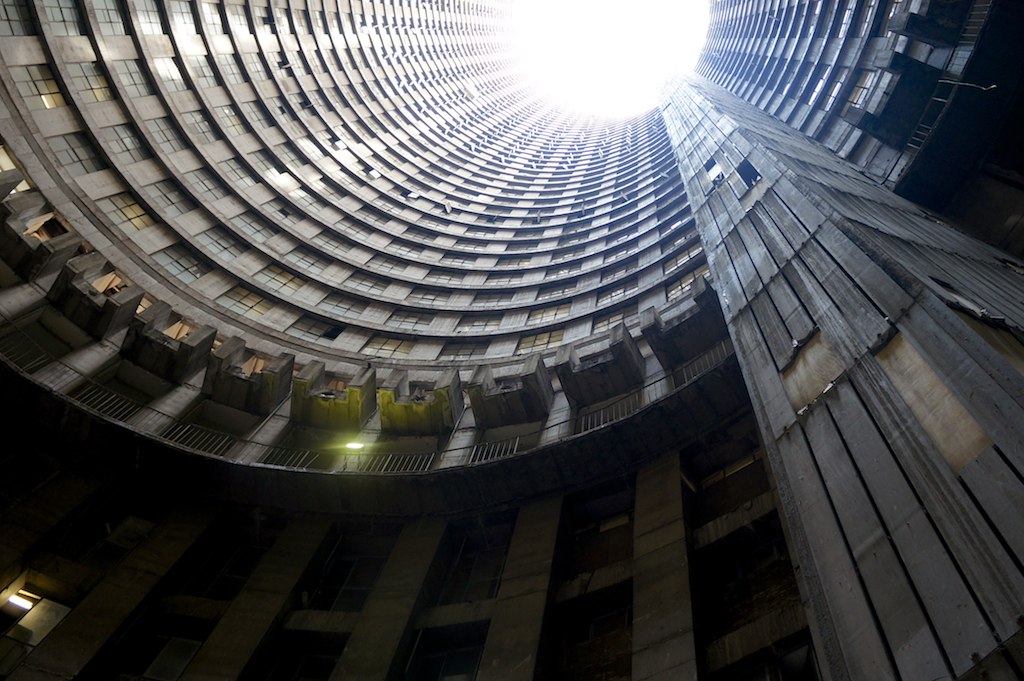The role of megaprojects and vertical slums in international planning. Johannesburg, Africa.
By Mark Werner
Introduction

The Ponte City Tower is a prominent high rise residential tower in Johannesburg’s central Hillbrow Neighborhood. “For many, the building symbolizes Johannesburg—because, over the past four decades, its fortunes have reflected the changing city around it” (Mars, 2017). In the 1960s the South African economy was booming due to the high value of gold, and the Hillbrow neighborhood became a wealthy, cosmopolitan center. With the influx of Europeans, the Ponte City Tower was represented as a symbol of the prosperity and modernity of a globalizing city. However, as social unrest began to grow towards the end of apartheid, it became a symbol of the violence of South Africa’s social system (Marinic 2017), and a mass exodus of white residents began. “By 1991 Hillbrow was overcrowded, dangerous, and virtually abandoned by the municipal government” (Marinic 2017), and Ponte City Tower had received the informal name of the ‘tallest urban slum in the world’. Today efforts are underway to turn Ponte City Tower and Hillbrow into an affordable and diverse community.
Analysis
The South African economy was booming in the early 1960s and developers set the stage for Johannesburg to be seen as a ‘global city’ rather than a mega-city (Robinson 2012). Robinson notes that ‘mega-cities’ are often associated with underdevelopment and informality, whereas ‘global cities’ project an image of development. As the sales brochure for Ponte City Tower suggested at the time, the building was “the ultimate in chic and sophistication” (Ponte City, A Residential Dream Comes True 1973) and an escape from the rest of underdeveloped Africa. However, when the municipal government cut trash collection and other public services in Hillbrow towards the end of apartheid, Ponte City Tower fell into disrepair and became in effect a vertical informal settlement with a form of self-rule. The decline of Hillbrow illustrates what the World Bank (2016) describes as the “products of failed policies, bad governance, corruption, inappropriate regulation, dysfunctional land markets, unresponsive financial systems, and a fundamental lack of political will”. As Roy (2005) explains, slum improvement will not succeed “if the state does not affirmatively address inequality”. Ponte City Tower was essentially the antithesis of equity, built to attract an elite class from afar at a time when such an opportunity was not available to a significant segment of the population in Johannesburg. Furthermore, this case illustrates the limits of the mobilities paradigm as the opportunity of the wealthy class to move reinforces the power they hold. Overseas residents first flocked to the Tower from Europe, and then, when crime began to increase and property values began to drop, these same residents had the opportunity to flee to the suburbs.
However, in recent years the tower has gained new a sense of place and community. The Kempston development firm bought the property in 2011, and today Ponte City Tower boasts renovated rooms, an internet cafe, fast-food restaurants, and increased security. Much like the initial developers of the property, Kempston’s goal was to make the brutalist Tower a “city-within-a-city” and provide it with a sense of community. Ponte City Tower is becoming a “place” once again (Shamsuddina and Ujang, 2008), offering accessible downtown housing, diversity in residents and services, and comfort of renovation and increased security. Shamsuddina and Ujand explain three constructs that establish a sense of place, including place attachment, dependence, and identity, all of which are becoming a reality in Ponte City Tower today. As Marinic (2017) suggests, it is “not merely a place to live, the complex has finally fulfilled its potential as a self-sufficient community of invested citizens rather than tenants,” and today it is over 90% occupied.
Implications

While there is no one solution to develop a society that is free from segregation, a lesson can be learned from Ponte City Tower. The tower was built to reflect an imaginary vision for the city, all the while ignoring the significant societal problems so prevalent in Johannesburg. What is important to understand is that planning models from the developed world cannot be directly replicated everywhere, nor should they be, as suggested by a variety of authors (Roy 2011, Watson 2002). Hillbrow has always been seen as a trendy diverse neighborhood, and the recent inclusion of diverse residents in Ponte City Tower has brought it out of a 20-30 year slump when it was virtually uninhabitable. Beyond diversity, ironically it was private investment under neoliberalism that sparked the Tower’s rejuvenation. In this way, it is similar to a case in Caracas, Venezuela, where the “Tower of David” began construction during prosperous times to serve as a banking and investment center similar to that of Wall Street in New York. As the economy of Venezuela slowed and the vision of Caracas as a global city began to fade, however, construction stopped. Squatters began to move in, developing their own shopping services, community structures, and systems to pay for utilities (Berg, 2016). However, while the Caracas city administration saw this unfinished building as an embarrassment and ordered the removal of the squatters, the Ponte City Tower has reemerged as a symbol of a prosperous Johannesburg.
